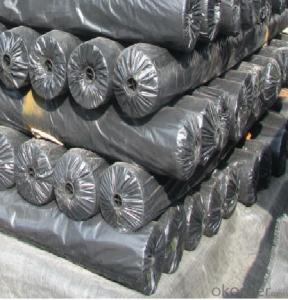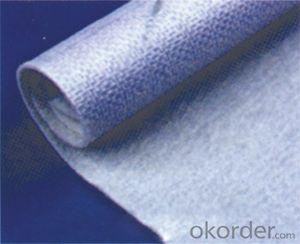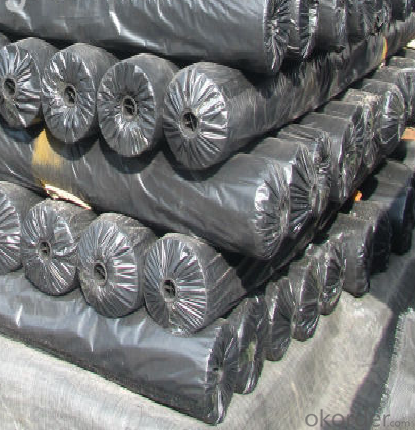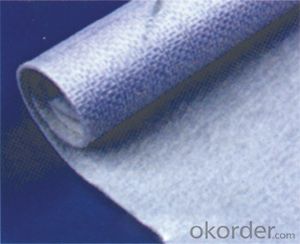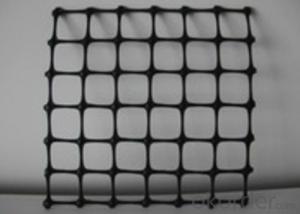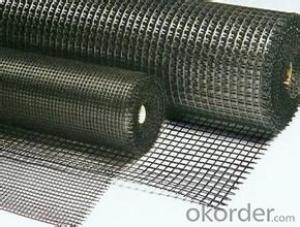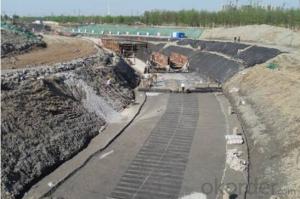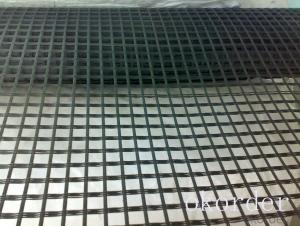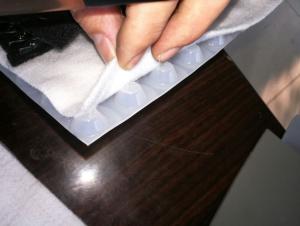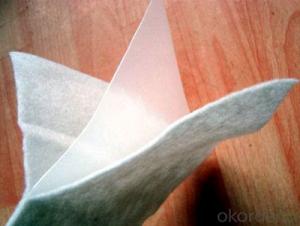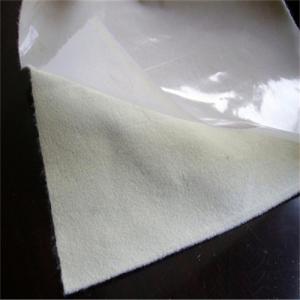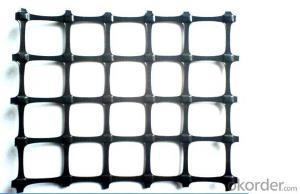Naue Geogrids Knitted Composite Geomembrane for Civil Construction
- Loading Port:
- Qingdao
- Payment Terms:
- TT OR LC
- Min Order Qty:
- 5000 m
- Supply Capability:
- 50000 m/month
OKorder Service Pledge
OKorder Financial Service
You Might Also Like
Specifications
High strength, anti-corrosion, tearing resistant and bursting resistant.
High strength polyester industrial yarns are adopted and, after treated with PVC laminating process, the geomembranes are abtained. These membranes prevent the permeation of water and change the defects of the current geomembranes with low strength and poor water resistance. As a result, they are widely used in such projects as the railroad foundation, dyke protective slopes, reservoirs, highway greenery belts, etc.
Application
Railroad foundations, tunnels, dykes, reservoirs, garbage filling fields, water-prevention and anti-permeation projects. Anti-seepage works of dyke. And application in anti-seepage works of water canal can save 80% of water.
Features
High strength, anti-corrosion, tearing resistant and bursting resistant.
Technical Parameters of Composite Geomembrane
Specification | PLGM-2020 | |
Performance | ||
Strength (kN/m) | Longitudinal | 20 |
Horizontal | 20 | |
Elogation | 30% | |
CBR strength (KN) | >2.5 | |
Thickness (mm) | >0.3 | |
Penetration coefficient (cm/s) | 10-11 | |
Width (m) | 2.5-3.5 | |
Length (m) | 30-50 | |
Functions
Ground stabilization
Drainage
Erosion control and re-vegetation
Revetment
Ground reinforcement
Asphalt underlayment
Road reinforcement
Features
1) Woven geotextile made on circle weave machine
2) Materials: polypropylene and other imported new materials
3) Weight per square meter: 80-700g/m²
4) Width: max. 6m
5) Perfect flexibility and against ultraviolet radiation and aging.
It can be widely used in areas of railways, highways, sport fields, earthwork projects, tunnels, coal mines, walls and slopes, environmental protection, and so on.
All colors and sizes can be customized.
Applications
1-Construction of roads and other trafficked areas (excluding railways and asphalt inclusion)
2-Construction of railways,
3-Earthworks, foundations and retaining structures,
4-Use in drainage systems,
5-Erosion control works (coastal protection, bank revetments),
6-Construction of reservoirs and dams,
7-Construction of canals,
8-Construction of tunnels and underground structures,
9-Use in solid waste disposals,
10-Use in liquid waste containment projects,
Woven Geotextiles Data Sheet
Item | Testing Method | Unit | ||
Grad Tensile Strength | ASTM-D 4632 | N | 890 | 1405 |
Grab Elongation | ASTM-D 4632 | % | ≤20 | ≤20 |
Puncture Strength | ASTM-D 4833 | N | 400 | 667 |
CBR Puncture | ASTM-D 6241 | N | 3200 | 4800 |
Mullen Burst | ASTM-D 3786 | kPA | 2578 | 4137 |
Trapezoidal Tear | ASTM-D 4533 | N | 500 | 750 |
Apparent Opening Size | ASTM-D 4751 | mm | 0.425 | 0.425 |
Permittivity | ASTM-D 4491 | Sec-1 | 0.05 | 0.05 |
Water Flow Rate | ASTM-D 4491 | 1/m/m2 | 163 | 163 |
UV Resistance | ASTM-D 4355 | % 500hrs | 70 | 70 |
Roll Width | m | 6 | 6 | |
Roll Length | m |
100 | 100 | |
Mass | GSM | 200 | 300
|
- Q: How do geogrids improve the stability of slopes?
- Geogrids improve the stability of slopes by providing reinforcement and preventing soil movement. They act as a barrier, distributing the forces exerted on the slope more evenly, reducing the risk of slope failure. Geogrids also increase the friction between soil layers, enhancing their shear strength and overall stability.
- Q: Production of geotextile manufacturers which good
- Needle punched nonwoven fabric and PE film composite geotextile:A specification film cloth, a cloth film two, maximum width of 4.2 meters is the main raw material to use acupuncture non-woven polyester staple fiber, PE film by composite, is mainly used for seepage control, applicable to rail, highway, tunnel, subway, airport project. Geotextile manufacturers can choose Wo environmental protection
- Q: What are the factors that affect the design of geogrid-reinforced structures?
- There are several factors that affect the design of geogrid-reinforced structures. Some of the key factors include the type and properties of the soil, the magnitude and direction of the applied loads, the desired level of stability and performance, the environmental conditions, and the available construction materials and methods. Additionally, factors such as the cost, aesthetics, and maintenance requirements may also influence the design decisions for geogrid-reinforced structures.
- Q: The cheapest two-way plastic geogrid manufacturers, two-way plastic geogrid prices?
- As the polymer in the manufacture of plastic polymer in the process of heating with the extension of the process of re orientation, strengthen the link between the molecular chain force, to achieve the purpose of improving its strength. Its elongation rate is only 10% ~ ~ of the original plate of 15%
- Q: Can geogrids be used for reinforcement in embankments and dams?
- Yes, geogrids can be used for reinforcement in embankments and dams. Geogrids are high-strength synthetic materials that are commonly used in civil engineering and construction projects to increase the stability and strength of soil structures. By incorporating geogrids into embankments and dams, they can effectively reinforce the soil, reduce settlement, and improve overall performance and durability of these structures.
- Q: Geogrid is mainly used for what?
- There are many kinds of geogrid, which can be divided into one-way geogrid, two-way geogrid, steel plastic grille (Mining Grid), fiberglass grille and warp knitted geogrid.
- Q: What are the factors to consider in selecting a geogrid for a specific application?
- When selecting a geogrid for a specific application, several factors need to be considered. These factors include the required strength and durability of the geogrid, the type and condition of the soil being reinforced, the anticipated load or traffic on the geogrid, the climate and environmental conditions of the project site, and the cost-effectiveness of the geogrid. Additionally, factors such as installation requirements, compatibility with other materials, and the availability of the geogrid in the required dimensions and specifications should also be taken into account.
- Q: How much is the geogrid 100KN
- Fiberglass grille price: 5 yuan
- Q: How does a geogrid work?
- A geogrid works by providing reinforcement to soil or other materials. It is typically made of high-strength polymers or fibers arranged in a grid-like pattern. When placed within the soil, the geogrid interlocks with the surrounding particles, creating a stable network. This enhances the tensile strength and overall performance of the soil, preventing excessive movement, erosion, or failure. The geogrid redistributes applied loads, reducing stress concentrations and improving the stability and longevity of structures like retaining walls, roadways, and embankments.
- Q: Can geogrids be used in geothermal energy systems?
- Yes, geogrids can be used in geothermal energy systems. Geogrids are often used to reinforce soil structures and provide stability, which can be beneficial in supporting the infrastructure and components of geothermal energy systems. They can help prevent soil erosion, provide load-bearing capacity, and enhance the overall performance and longevity of the system.
Send your message to us
Naue Geogrids Knitted Composite Geomembrane for Civil Construction
- Loading Port:
- Qingdao
- Payment Terms:
- TT OR LC
- Min Order Qty:
- 5000 m
- Supply Capability:
- 50000 m/month
OKorder Service Pledge
OKorder Financial Service
Similar products
Hot products
Hot Searches
Related keywords
